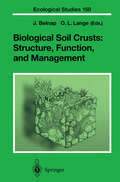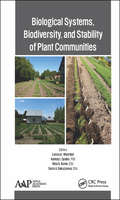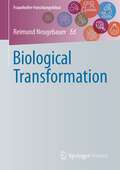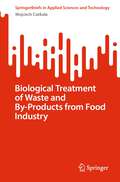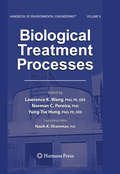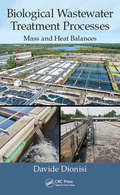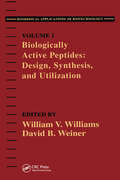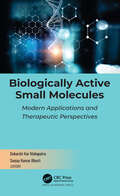- Table View
- List View
Biological Prototypes and Synthetic Systems: Volume 1 Proceedings of the Second Annual Bionics Symposium sponsored by Cornell University and the General Electric Company, Advanced Electronics Center, held at Cornell University, August 30–September 1, 1961
by E. E. BernardWhen the present symposium was first conceived, it was decided that more emphasis be given to contributions from biological laboratories than has typically appeared in previous bionics meetings. Accordingly, most of the invited speakers are biologists, in the broad sense of representing some area of the life sciences. Likewise, many of the submitted papers eventually chosen by the technical com mittee were from the life sCiences, rather than the physical sciences or mathe matics. In this way, it was hoped that a greater direct interest in the technological problems of bionics might be stimulated among biologists, upon whose work much of the success of bionics necessarily lies. Because of the wide interdisciplinary span of the papers, it was necessary to impose some artificial organization upon them, specifically for continuity in the transactions. We elected to put the biological papers first, followed by those which deal with reasonably specific models, and reserveto the last those papers reporting models which are more general in nature. The editorial function was kept to a minimum, with no major alterations of content and few of style being exercised. Several of the papers delivered at the symposium required a longer format for clarity and are included here in ex panded versions. Assitance in the preparation of this volume was received from the National Institute of Neurologic Diseases and Blindness, Grant number B-3896.
Biological Radiation Effects
by Jürgen KieferThe biological action of radiation undoubtedly constitutes an issue of actual con cern, particularly after incidences like those in Harrisburg or Chernobyl. These considerations, however, were not the reason for writing this book although it is hoped that it will also be helpful in this respect. The interaction of radiation with biological systems is such an interesting research objective that to my mind no special justification is needed to pursue these problems. The combination of physics, chemistry and biology presents on one hand a fascinating challenge to the student, on the other, it may lead to insights which are not possible if the dif ferent subjects remain clearly separated. Special problems of radiation biology have quite often led to new approaches in physics (or vice versa), a recent example is "microdosimetry" (chapter 4). Biological radiation a9tion comprises all levels of biological organization. It starts with the absorption in essential atoms and molecules and ends with the development of cancer and genetic hazards to future generations. The structure of the book reflects this. Beginning with physical and chemical fundamentals, it then turns to a description of chemical and subcellular systems. Cellular effects form a large part since they are the basis for understanding all further responses. Reactions of the whole organism, concentrating on mammals and especially humans, are subsequently treated. The book concludes with a short discussion of problems in radiation protection and the application of radiation in medical therapy. These last points are necessarily short and somewhat superficial.
Biological Resource Management Connecting Science and Policy
by Ervin BalázsJointly published with INRA, Paris.The application of new production methods in the food industry - genetic engineering in plants and animals - as well as recent crises over food-borne diseases have led consumers to a growing concern about science as an appropriate basis for developing sound agricultural policies. This book presents the discussion of scientists and politicians in the framework of an OECD programme conference on how to restore public trust in the application of new scientific achievements concerning food production.
Biological Resources and Migration
by Dietrich WernerMigration of humans and animals, plants and even microbes is a ubiquitous global phenomenon. This book covers all forms of migration - plant, microbial, animal or human - and their mutual impact in detail. The contributions in this book are the result of an innovative International Conference and OECD Workshop aimed at triggering off the interdisciplinary dialogue between natural scientists and socioeconomists.
Biological Responses to Nanoscale Particles: Molecular and Cellular Aspects and Methodological Approaches (NanoScience and Technology)
by Peter Gehr Reinhard ZellnerIn this book the recent progress accumulated in studies of the interaction of engineered nanoparticles with cells and cellular constituents is presented. The focus is on manufacturing and characterization of nanosized materials, their interactions with biological molecules such as proteins, the mechanisms of transport across biological membranes as well as their effects on biological functions. Fundamental molecular and cellular aspects are in the foreground of the book. A further particularity is the interdisciplinary approach, including fields such as preparatory and analytical chemistry, biophysics and the physics of colloids, advanced microscopy and spectroscopy for in-situ detection of nanoparticles, cellular toxicology and nanomedicine. Nanoscale particles are known to exhibit novel and unprecedented properties that make them different from their corresponding bulk materials. As our ability to control these properties is further advanced, a huge potential to create materials with novel properties and applications emerges. Although the technological and economic benefits of nanomaterials are indisputable, concerns have also been raised that nanoscale structuring of materials might also induce negative health effects. Unfortunately, such negative health effects cannot be deduced from the known toxicity of the corresponding macroscopic material. As a result, there is a major gap in the knowledge necessary for assessing their risk to human health.
Biological Signals Classification and Analysis (Lecture Notes in Bioengineering)
by Kamran KiasalehThis authored monograph presents key aspects of signal processing analysis in the biomedical arena. Unlike wireless communication systems, biological entities produce signals with underlying nonlinear, chaotic nature that elude classification using the standard signal processing techniques, which have been developed over the past several decades for dealing primarily with standard communication systems. This book separates what is random from that which appears to be random and yet is truly deterministic with random appearance. At its core, this work gives the reader a perspective on biomedical signals and the means to classify and process such signals. In particular, a review of random processes along with means to assess the behavior of random signals is also provided. The book also includes a general discussion of biological signals in order to demonstrate the inefficacy of the well-known techniques to correctly extract meaningful information from such signals. Finally, a thorough discussion of recently proposed signal processing tools and methods for addressing biological signals is included. The target audience primarily comprises researchers and expert practitioners but the book may also be beneficial for graduate students.
Biological Soft Matter: Fundamentals, Properties, and Applications
by Corinne NardinExplore a comprehensive, one-stop reference on biological soft matter written and edited by leading voices in the field Biological Soft Matter: Fundamentals, Properties and Applications delivers a unique and indispensable compilation of up-to-date knowledge and material on biological soft matter. The book presents a thorough overview about biological soft matter, beginning with different substance classes, including proteins, nucleic acids, lipids, and polysaccharides. It goes on to describe a variety of superstructures and aggregated and how they are formed by self-assembly processes like protein folding or crystallization. The distinguished editors have included materials with a special emphasis on macromolecular assembly, including how it applies to lipid membranes, DNA condensation, and DNA fibrillization. Biological Soft Matter is a crucial resource for anyone working in the field, compiling information about all important substance classes and their respective roles in forming superstructures. The book is ideal for beginners and experts alike and makes the perfect guide for chemists, physicists, and life scientists with an interest in the area. Readers will also benefit from the inclusion of: An introduction to DNA nano-engineering and DNA-driven nanoparticle assembly Explorations of polysaccharides and glycoproteins, engineered biopolymers, and engineered hydrogels Discussions of macromolecular assemblies, including liquid membranes and small molecule inhibitors for amyloid aggregation A treatment of inorganic nanomaterials as promoters and inhibitors of amyloid fibril formation An examination of a wide variety of natural and artificial polymers Perfect for materials scientists, biochemists, polymer chemists, and protein chemists, Biological Soft Matter: Fundamentals, Properties and Applications will also earn a place in the libraries of biophysicists and physical chemists seeking a one-stop reference summarizing the rapidly evolving topic of biological soft matter.
Biological Soft Matter: Fundamentals, Properties, and Applications
by Corinne Nardin Helmut SchlaadExplore a comprehensive, one-stop reference on biological soft matter written and edited by leading voices in the field Biological Soft Matter: Fundamentals, Properties and Applications delivers a unique and indispensable compilation of up-to-date knowledge and material on biological soft matter. The book presents a thorough overview about biological soft matter, beginning with different substance classes, including proteins, nucleic acids, lipids, and polysaccharides. It goes on to describe a variety of superstructures and aggregated and how they are formed by self-assembly processes like protein folding or crystallization. The distinguished editors have included materials with a special emphasis on macromolecular assembly, including how it applies to lipid membranes, DNA condensation, and DNA fibrillization. Biological Soft Matter is a crucial resource for anyone working in the field, compiling information about all important substance classes and their respective roles in forming superstructures. The book is ideal for beginners and experts alike and makes the perfect guide for chemists, physicists, and life scientists with an interest in the area. Readers will also benefit from the inclusion of: An introduction to DNA nano-engineering and DNA-driven nanoparticle assembly Explorations of polysaccharides and glycoproteins, engineered biopolymers, and engineered hydrogels Discussions of macromolecular assemblies, including liquid membranes and small molecule inhibitors for amyloid aggregation A treatment of inorganic nanomaterials as promoters and inhibitors of amyloid fibril formation An examination of a wide variety of natural and artificial polymers Perfect for materials scientists, biochemists, polymer chemists, and protein chemists, Biological Soft Matter: Fundamentals, Properties and Applications will also earn a place in the libraries of biophysicists and physical chemists seeking a one-stop reference summarizing the rapidly evolving topic of biological soft matter.
Biological Soil Crusts: Structure, Function, and Management (Ecological Studies #150)
by Jayne Belnap Otto L. LangeBiological Systems, Biodiversity, and Stability of Plant Communities
by Larissa I. Weisfeld Anatoly I. Opalko Nina A. Bome Sarra A. BekuzarovaThis book discusses theoretical approaches to the taxonomy of biological systems and theory and mathematical approaches to the problem of plant diversity, cultivation, and the environment. Particular attention is given to theoretical and practical problems of soil and the environmental sustainability of phytocoenosis, with the goal to enhance the p
Biological Transformation
by Reimund NeugebauerThe global population is expected to rise to 9.8 billion by the year 2050 - with everyone ultimately striving for prosperity. New methods must therefore be found to achieve more efficient production. Research to date shows that the biological inventory that has evolved: its products, processes, principles and tools, can spur modern technology. The development of technological innovations based on biological concepts, with the goal of particularly innovative and sustainable value creation, today is collectively known as "biological transformation". It results in highly functional products with striking properties that can be both manufactured and utilized in a resource-saving way.In terms of taking responsibility of the good of all people, biological transformation is therefore a path that applied research will have to take. The Fraunhofer-Gesellschaft has recognized the developmental technology potential of biological transformation and sees it as its task not only to drive the relevant research forward, but also to promote public awareness of the topic.
Biological Treatment of Waste and By-Products from Food Industry (SpringerBriefs in Applied Sciences and Technology)
by Wojciech CzekałaThis book discusses selected waste and by-products of the food industry. Two commonly used methods of managing these are discussed: anaerobic digestion and composting. The book reviews current research and also brings in the author’s own research insights to the discussion. The book is aimed at food industry specialists, waste management specialists, scientists, and students. However, the book describes problems in an accessible way, which will make this book useful for beginners in the waste/biogas/composting sector.
Biological Treatment Processes: Volume 8 (Handbook of Environmental Engineering #8)
by Nazih K. ShammasPollution and its effects on the environment have emerged as critical areas of research within the past 30 years. The Handbook of Environmental Engineering is a collection of methodologies that study the effects of pollution and waste in their three basic forms: gas, solid, and liquid. In Volume 8, Biological Treatment Processes, tried-and-true solutions comprise a “methodology of pollution control”. The distinguished panel of authors contributes detailed chapters, which include topics ranging from treatment by land application, activated sludge processes, and submerged aeration to trickling filters, lagoons, rotating biological contactors, sequencing batch reactors, digestions, and composting. Volume 8 and its sister book - Volume 9: Advanced Biological Treatment Processes – are designed as both basic biological waste treatment textbooks and reference books for advanced undergraduate and graduate students – as well as for designers of waste treatment systems, scientists, and researchers. An indispensable addition to the Humana Press series, Volume 8: Biological Treatment Processes provides an illuminating look at water pollution control and the fascinating evolution of bio-environmental engineering.
Biological Treatment Processes: Volume 3 (Handbook of Environmental Engineering #3)
by Lawrence K. Wang Norman C. PereiraThe past few years have seen the emergence of a growing, widespread desire in this country, and indeed everywhere, that positive actions be taken to restore the quality of our environment, and to protect it from the degrading effects of all forms of pollution-air, noise, solid waste, and water. Since pollution is a direct or indirect consequence of waste, if there is no waste, there can be no pollution, and the seemingly idealistic demand for "zero discharge" can be construed as a demand for zero waste. However, as long as there is waste, we can only attempt to abate the consequent pollution by converting it to a less noxious form. In those instances in which a particular type of pollution has been recognized, three major questions usually arise: (1) How serious is the pollution? (2) Is the technology to abate it available? and (3) Do the costs of abatement justify the degree of abatement achieved? The principal intention of this series of books on environmental engineering is to help the reader formu late useful answers to the second and third of these questions, i. e. , to outline the best currently available engineering solutions, and to examine their costs in the light of the real level of benefits afforded. The traditional approach of applying tried-and-true solutions to specific pollution problems has been a major factor contributing to the success of environmental engineering, and in large measure has ac counted for the establishment of a "methodology of pollution control.
Biological Wastewater Treatment Processes: Mass and Heat Balances
by Davide DionisiThe focus of the book is on how to use mass and heat balances to simulate and design biological wastewater treatment processes. All the main processes for biological wastewater treatment are covered viz. activated sludge processes for carbon and nitrogen removal, anaerobic digestion, sequencing batch reactors, and attached growth processes.
Biological Wastewater Treatment Processes: Mass and Heat Balances
by Davide DionisiThe focus of the book is on how to use mass and heat balances to simulate and design biological wastewater treatment processes. All the main processes for biological wastewater treatment are covered viz. activated sludge processes for carbon and nitrogen removal, anaerobic digestion, sequencing batch reactors, and attached growth processes.
Biologically Active Peptides: Design, Synthesis and Utilization
by David B. Weiner William V. WilliamsInvestigation into basic and advanced peptide design, synthesis, evaluation and utilization. New therapeutic approaches from experimental systems.
Biologically Active Peptides: Design, Synthesis and Utilization
by David B. Weiner William V. WilliamsInvestigation into basic and advanced peptide design, synthesis, evaluation and utilization. New therapeutic approaches from experimental systems.
Biologically Active Small Molecules: Modern Applications and Therapeutic Perspectives
by Debarshi Kar Mahapatra Sanjay Kumar BhartiBiologically Active Small Molecules: Modern Applications and Therapeutic Perspectives focuses on small molecules as active pharmacological agents, their pharmacotherapeutically active properties, new approaches in drug discovery using small molecules, and biopharmaceutic approaches for low molecular weight ligands. Molecules of low mass play a pivotal role in pharmacology because they exhibit multifarious pharmacological effects. Small molecules have become universally popular due to their simple chemistry, easy separation techniques, versatile acceptance for computational studies, large number of places for the substitution of active chemical moieties by well-established synthetic routes with less effort, better quality attributes, and ability to demonstrate numerous biological activities. This book provides a multidisciplinary approach that delivers the most updated knowledge and advances of some newly developed therapeutically active low molecular weight compounds. It includes chapters that present up-to-date and concise content on the classification, structures, chemical syntheses, medicinal chemistry, pharmacology, biochemical pathways, mechanism of actions, side effects, and adverse effects of small molecule drug discovery. The book covers a broad area by highlighting the advances of inter- and multidisciplinary fields of medicine, chemical sciences, and pharmaceuticals. The flowcharts, figures, illustrations, and diagrams provide important information and will be of great interest for readers.
Biologically Active Small Molecules: Modern Applications and Therapeutic Perspectives
by Debarshi Kar Mahapatra Sanjay Kumar BhartiBiologically Active Small Molecules: Modern Applications and Therapeutic Perspectives focuses on small molecules as active pharmacological agents, their pharmacotherapeutically active properties, new approaches in drug discovery using small molecules, and biopharmaceutic approaches for low molecular weight ligands. Molecules of low mass play a pivotal role in pharmacology because they exhibit multifarious pharmacological effects. Small molecules have become universally popular due to their simple chemistry, easy separation techniques, versatile acceptance for computational studies, large number of places for the substitution of active chemical moieties by well-established synthetic routes with less effort, better quality attributes, and ability to demonstrate numerous biological activities. This book provides a multidisciplinary approach that delivers the most updated knowledge and advances of some newly developed therapeutically active low molecular weight compounds. It includes chapters that present up-to-date and concise content on the classification, structures, chemical syntheses, medicinal chemistry, pharmacology, biochemical pathways, mechanism of actions, side effects, and adverse effects of small molecule drug discovery. The book covers a broad area by highlighting the advances of inter- and multidisciplinary fields of medicine, chemical sciences, and pharmaceuticals. The flowcharts, figures, illustrations, and diagrams provide important information and will be of great interest for readers.
Biologically Inspired Approaches for Locomotion, Anomaly Detection and Reconfiguration for Walking Robots (Cognitive Systems Monographs #14)
by Bojan JakimovskiThe increasing presence of mobile robots in our everyday lives introduces the requirements for their intelligent and autonomous features. Therefore the next generation of mobile robots should be more self-capable, in respect to: increasing of their functionality in unforeseen situations, decreasing of the human involvement in their everyday operations and their maintenance; being robust; fault tolerant and reliable in their operation.Although mobile robotic systems have been a topic of research for decades and aside the technology improvements nowadays, the subject on how to program and making them more autonomous in their operations is still an open field for research.Applying bio-inspired, organic approaches in robotics domain is one of the methodologies that are considered that would help on making the robots more autonomous and self-capable, i.e. having properties such as: self-reconfiguration, self-adaptation, self-optimization, etc.In this book several novel biologically inspired approaches for walking robots (multi-legged and humanoid) domain are introduced and elaborated. They are related to self-organized and self-stabilized robot walking, anomaly detection within robot systems using self-adaptation, and mitigating the faulty robot conditions by self-reconfiguration of a multi-legged walking robot. The approaches presented have been practically evaluated in various test scenarios, the results from the experiments are discussed in details and their practical usefulness is validated.
A Biologically Inspired CMOS Image Sensor (Studies in Computational Intelligence)
by Mukul Sarkar Albert TheuwissenBiological systems are a source of inspiration in the development of small autonomous sensor nodes. The two major types of optical vision systems found in nature are the single aperture human eye and the compound eye of insects. The latter are among the most compact and smallest vision sensors. The eye is a compound of individual lenses with their own photoreceptor arrays. The visual system of insects allows them to fly with a limited intelligence and brain processing power. A CMOS image sensor replicating the perception of vision in insects is discussed and designed in this book for industrial (machine vision) and medical applications. The CMOS metal layer is used to create an embedded micro-polarizer able to sense polarization information. This polarization information is shown to be useful in applications like real time material classification and autonomous agent navigation. Further the sensor is equipped with in pixel analog and digital memories which allow variation of the dynamic range and in-pixel binarization in real time. The binary output of the pixel tries to replicate the flickering effect of the insect’s eye to detect smallest possible motion based on the change in state. An inbuilt counter counts the changes in states for each row to estimate the direction of the motion. The chip consists of an array of 128x128 pixels, it occupies an area of 5 x 4 mm2 and it has been designed and fabricated in an 180nm CMOS CIS process from UMC.
Biologically Inspired Cognitive Architectures: Proceedings of the First International Early Research Career Enhancement School on BICA and Cybersecurity (FIERCES 2017) (Advances in Intelligent Systems and Computing #636)
by Valentin V. Klimov Alexei V. SamsonovichThis book includes papers from the second year of the prestigious First International Early Research Career Enhancement School (FIERCES) series: a successful, new format that puts a school in direct connection with a conference and a social program, all dedicated to young scientists. Reflecting the friendly, social atmosphere of excitement and opportunity, the papers represent a good mixture of cutting-edge research focused on advances towards the most inspiring challenges of our time and first ambitious attempts at major challenges by as yet unknown, talented young scientists. In this second year of FIERCES, the BICA Challenge (to replicate all the essential aspects of the human mind in the digital environment) meets the Cybersecurity Challenge (to protect all the essential assets of the human mind in the digital environment), which is equally important in our age. As a result, the book fosters lively discussions on today’s hot topics in science and technology, and stimulates the emergence of new cross-disciplinary, cross-generation and cross-cultural collaboration. FIERCES 2017, or the First International Early Research Career Enhancement School on Biologically Inspired Cognitive Architectures and Cybersecurity, was held on August 1–5 at the Baltschug Kempinski in Moscow, Russia.
Biologically Inspired Cognitive Architectures: Proceedings of the First International Early Research Career Enhancement School (FIERCES 2016) (Advances in Intelligent Systems and Computing #449)
by Alexei V. Samsonovich Valentin V. Klimov Galina V. RybinaThis book presents cutting-edge research focused on current challenges towards the realization of Biologically Inspired intelligent agents, or Cognitive Architectures (BICA). The chapters are written by both world-recognized experts (including Antonio Chella, Olivier Georgeon, Oliver Kutz, Antonio Lieto, David Vernon, Paul Verschure, and others) and young researchers. Together, they constitute a good mixture of new findings with tutorial-based reviews and position papers, all presented at the First International Early Research Career Enhancement School on Biologically Inspired Cognitive Architectures (FIERCES on BICA 2016), held April 21-24 in Moscow, Russia. Most works included here cross boundaries between disciplines: from neuroscience to social science, from cognitive science to robotics, and from bioengineering to artificial intelligence. A special emphasis is given to novel solutions to urgent problems that have been resisting traditional approaches for decades. Intended for providing readers with an update on biologically inspired approaches towards the computational replication of all the essential aspects of the human mind (the BICA Challenge), this book is expected to foster lively discussions on the topic and stimulate cross-disciplinary, cross-generation and cross-cultural collaboration.
Biologically Inspired Cognitive Architectures 2012: Proceedings of the Third Annual Meeting of the BICA Society (Advances in Intelligent Systems and Computing #196)
by Roberto Pirrone Rosario Sorbello Kamilla Rún Jóhannsdóttir Antonio ChellaThe challenge of creating a real-life computational equivalent of the human mind requires that we better understand at a computational level how natural intelligent systems develop their cognitive and learning functions. In recent years, biologically inspired cognitive architectures have emerged as a powerful new approach toward gaining this kind of understanding (here “biologically inspired” is understood broadly as “brain-mind inspired”). Still, despite impressive successes and growing interest in BICA, wide gaps separate different approaches from each other and from solutions found in biology. Modern scientific societies pursue related yet separate goals, while the mission of the BICA Society consists in the integration of many efforts in addressing the above challenge. Therefore, the BICA Society shall bring together researchers from disjointed fields and communities who devote their efforts to solving the same challenge, despite that they may “speak different languages”. This will be achieved by promoting and facilitating the transdisciplinary study of cognitive architectures, and in the long-term perspective – creating one unifying widespread framework for the human-level cognitive architectures and their implementations. This book is a proceedings of the Third Annual Meeting of the BICA Society, which was hold in Palermo-Italy from October 31 to November 2, 2012. The book describes recent advances and new challenges around the theme of understanding how to create general-purpose humanlike artificial intelligence using inspirations from studies of the brain and the mind.






